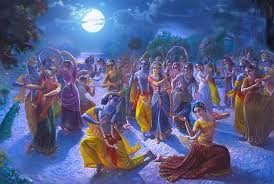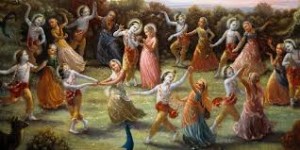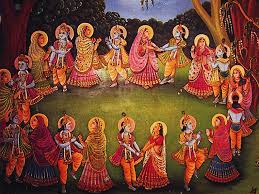
Effect of Krishna Schools: Views of Former Students
By Urmila devi dasi
Introduction
We were taught to be independent thinkers—think outside of the box. We would analyze other philosophy and our own philosophy critically, not just doing this because it’s what my mommy did but because it’s the truth and it will make me happy. It was validated year after year. (Kalindi , one of the interviewees who received her primary and secondary education in Hare Krishna schools.)
Throughout most of the world, religious organizations have primary and secondary schools where students can gain knowledge and experience of their tradition in the context of academic learning. Whereas in some countries nearly all schools are religiously based, it is far more the norm in most nations for various religious denominations to have schools side by side with secular educational institutions. Some countries, such as New Zealand and the Netherlands, offer a wide range of support, including financial, to religious schools. In most nations with secular governments, however, a religious school is a private enterprise that exists primarily due to the dedication of staff and parents.
Although faith is fragile for students of religious homes learning in a secular culture (MacMullen, 2004), the mainstream educational research literature all but ignores religious groups in studies of multiculturalism (Grace, 2003). Not only are there almost no studies of students from various religious cultures in secular schools, but also neither secular nor religious educators and researchers attempt many empirical studies of faith-based schools and their effect on their students and society (Dickson, 2004; Dijkstra & Veenstra, 2001; Driesson, 2002; Grace, 2003). There are even very few theoretical models of the value of religious schools, or the effect upon children from religious homes who attend secular schools (Driesson, 2002; Grace, 2003; MacMullen, 2004).
A society in which people from diverse backgrounds, with individual strengths and challenges, work together for the common good is one definition of an ideal democracy (Kahne, 1994). Therefore, “education within a pluralistic society should affirm and help students understand their home and community cultures. However, it should also help free them from their cultural boundaries” (Banks, 1999, p. 4).
Conceptual Framework
Collective cultural identity, or strengthening students’ identification with a faith community, is generally a goal of religious schools (Frances, 2002) and is often necessary in order for individuals to embrace a religious faith (Rochford, 1999). At the same time, religious schools help students to make autonomous choices about individual identity through training in knowledge about their families’ religion, as well as having opportunities to experience that religion by practice (MacMullen, 2004). Religious knowledge includes the epistemology, or process of discerning the good. Members of a faith community generally share the same epistemology, even if their specific conclusions about what is good differ from one another (Dagovitz, 2004). Beyond accepting an epistemology, an affective experience of the good is essential in order to make moral choices (Ferrari & Okamoto, 2003; James, 1902; Piaget, 1962), and one purpose of religious schools is to imbue students with a moral sense (Johnson, 2002).
Based on the above premises, there are two main concepts in this study’s conceptual framework, that of spiritual transformation and that of identity. Identity, individual and collective, serves as a foundation for spiritual transformation. At the same time, spiritual experience and its branches reinforce individual and collective identity. Moral behaviors may set the stage for religious practice, which leads to knowledge, and then spiritual transformation. As a person becomes spiritually transformed, he or she will become inspired to act morally, practice religion, and develop knowledge. The circle can start at any point and each element tends to increase the others, though the goal is spiritual transformation. Religious schools can contribute to each of these interrelated parts of the goal of students’ religious education. (See download files for figure.)
Without knowing something about the effects of religious schools regarding topics such as affective spiritual experiences and autonomous identity—some of the primary reasons for such schools’ existence—it is almost impossible for educational leaders and teachers to emphasize what parts of their program are effective and what parts should be modified or discarded.
The Hare Krishna Movement
The Vaisnava religious tradition, a major part of a spiritual heritage based on the sacred writings of the Vedas, is one of the oldest religions on earth. The Gaudiya section of Vaisnavism is a few hundred years old, and its manifestation as the Hare Krishna Movement, or International Society for Krishna Consciousness (ISKCON) has been extant for only 40 years. ISKCON’s first primary school opened in Dallas, Texas, in the late 1960s. Since then, primary and secondary schools have started worldwide, with by far the largest number of enrolled students in India.
Practically all the research on ISKCON has been done through ethnographies or other qualitative methods. The focus of research (Braswell, 1986; Cox, Shinn, Hopkins, Basham, & Shrivatsa, 1983; Danier, 1974; Mukunda, 2001; Rochford, 1985, 1992, 1995; Rosen, 1992; Shinn, 1987; Weiss & Mendoza, 1990) has been on why people join ISKCON, how ISKCON is organized socially, the religious and philosophical tradition on which it is based, and the mental health of members. One of the few quantitative studies was that of Weiss and Mendoza (1990) who found that members had mental health comparable to those in more traditional Western religions, with the only significant finding being a greater sense of well-being associated with increased acculturation. However, they conclude that the existence of two strong concomitant factors does not imply causality. It is also unclear whether their definition of acculturation is similar to that of Anthony’s (2003) inculturation that involves synergy between a person’s religion and the surrounding culture.
Much of the qualitative research (such as Danier, 1974; Mukunda, 2001; Shin, 1987) has an emphasis both on the inner life of members and the degree to which they both have their own religious identity and can function in the larger society. Researchers agree (for example, Shinn, 1987) that members have made an autonomous decision to adopt a Hare Krishna lifestyle, often after extended study of the religion. All researchers note the ISKCON belief in one God—called Krishna—who is loving and personal, the doctrine of karma and reincarnation, and a lifestyle that includes avoiding illicit sex, intoxication, gambling, and the eating of meat, fish, or eggs.
Also relevant to this study, though not a study of ISKCON members per se, is a true experiment as to whether chanting the Hare Krishna mantra would increase the mode of goodness as explained in sacred writings such as the Bhagavad-gita. Goodness involves “understanding by which one knows what ought to be done and what ought not to be done, what is to be feared and what is not to be feared, what is binding and what is liberating (Bhagavad-gita, 18.30). A person in goodness will feel mentally satisfied, be self-controlled, honest, wise, clean, not unnecessarily violent, and will speak only what is both truthful and beneficial in such a way that others are not disturbed (Bhurijana, 1995, p. 417). The findings of Wolf and Abell (2003) showed a significant positive correlation between the spiritual practice of chanting Hare Krishna and the mode of goodness, including an increase in peacefulness and general mental health.
Schools and Children of the Hare Krishna Movement
Almost all the literature on ISKCON concerns adults. A few magazine and newspaper articles, as well as some television shows, have focused on Krishna children and schools, but none of these has been a rigorous qualitative or quantitative study. The first, and possibly only, thorough study of an ISKCON school (Lilliston, 1985) involved two weeks of observation and coding of student behavior. This took place at a boarding school in upstate New York. Unstructured interviews with teachers, administrators, and some parents, loosely focused on: (a) expectations for the children, (b) interpretations of children’s behavior, and (c) relating perceptions and beliefs to the philosophy of Krishna consciousness (p. 5). In addition to observations of the 72 children aged five to 15 years, Lilliston also administered a series of clinical assessments to 30 of the students. Assessments included the Standford Binet, some norm-referenced achievement tests, a moral dilemmas measure, and projective story telling. He also interviewed each child. He found no greater psychiatric problems than exist in the general population. Academically, students were, on average, one to three grades ahead of their public school peers, with an average I.Q. of 106. He found the children normal on measures of creativity, moral reasoning (80% in terms of interpersonal sensitivity, with the majority of children reasoning in terms of justice), self-monitoring, self-regulation (in which they were significantly high), spontaneity, and situational discrimination (in which they were significantly high).
While Lilliston’s (1985) study indicates a possible positive correlation between the school and children’s academic and moral development, the research was not controlled for other factors such as family level of education, income, and so forth. The primary aim of the research was to determine if there was any harm to the children, with results quite the opposite. However, no conclusions about the moral behavior, inculturation, religious beliefs, spiritual experience, or religious practice of former students who are now adults can be deduced from this study.
A very different kind of study, involving interviews, surveys, and observation (Rochford, 1999) examined the social and religious identity of students who were educated in ISKCON primary boarding schools in the 1970s and 80s. Most of these students then attended secular public high schools. Some of the students studied either continued in ISKCON schools at the secondary level, or were home schooled for their high school experience. Rochford’s data came from a survey of 87 former ISKCON school students, who had an average age of 18-19. He also conducted open-ended interviews with another 47 former ISKCON school students, 30 of whom were in their late teens or early twenties, and 17 of whom were still in secondary school.
Rochford (1999) found a significant difference between the students who attended an ISKCON or a secular high school in terms of their identification with the Hare Krishna religion, with those who attended ISKCON schools being more likely to self-identify as a devotee of Krishna. In general, students who attended secular high schools felt awkward and embarrassed about their identity with ISKCON, and often tried to assimilate. These attempts resulted in students having their primary social relationships with other students who were not also ISKCON members as a way to hide their identity. Slightly over half ended up engaging in aspects of modern American youth culture, which often included illicit sex, as well as drug and alcohol use. It is notable that only seven of the 87 youths surveyed indicated that they had ever tried meat; only three regularly ate non-vegetarian food. Meat-eating is one of the strongest taboos for devotees of Krishna.
It appears that the primary boarding schools that educated the youth in Rochford’s (1999) study had an exclusive/aggressive attitude towards any but the culture associated with the Krishna faith, according to Anthony’s (2003) definition. With this attitude, the students risk being in a kind of cultural “ghetto” or perhaps finding their religion irrelevant. Students were, thus, ill prepared to retain their own identity while functioning in society. Many of them felt torn between worlds, and took many years to be settled in their identity.
The only other study this researcher could find on adolescents or adults who had attended ISKCON schools was a survey (Manu, 1998) of ISKCON youth an average of nine years after they had left an ISKCON school. Because Manu’s data is probably one of the only two studies ever done on youth who attended Hare Krishna schools, it is included in this study. However, only the raw data are available, without any interpretation or analysis, and the low response rate makes this study susceptible to sample errors. The average age of respondents was approximately 22 years. Out of the 500 surveys mailed, 71 responded, leaving the study open to sampling error. Between 20-76% had experienced some negative, distressing problem during their schooling. Yet about 90% continued to accept Krishna as God, and about 74% self-identified as a devotee of Krishna. Yet 62% were having illicit sex, 38% were taking some kind of intoxication (which would include caffeine and tobacco), about 10% were gambling, and about 5% were eating non-vegetarian food. About 60% engaged in the most important spiritual activity of chanting Krishna’s names.
While Manu’s study (1998) is extremely relevant, being the only research done on adults who attended ISKCON’s schools, there are many unanswered questions. Some of the questions deal with possible problems in the study itself, whether because of sampling errors, or bias because of question wording. In addition, there does not seem to be any controlling in this study for how religious the families of origin are, socio-economic status, country of residence, and so forth. Finally, if Ferrari and Okamoto (2003) are correct in understanding that emotional, religious experience is the basis of morality, then questions relating to these experiences would also have been invaluable.
Research on schools and children in ISKCON is so scarce that it is difficult to draw any conclusions. There are some suggestions that ISKCON schools need to prepare students for living in cultures alien to that of the children’s faith, and that students who attended ISKCON schools in the 70s and 80s tend to accept religious beliefs and practices, but not necessarily moral behavior stressed in the Krishna religion. The schools in ISKCON are radically different now than when these studies were done, and little from the studies can be extrapolated to the present situation.
Research Questions
I wanted to find out what parts of attending a Krishna school had the most impact on former students, in both positive and negative ways. My particular interests centered on spiritual transformation and identity negotiation. In the area of spiritual transformation, I wanted to know whether or not former students would recall either isolated or ongoing personal experiences that gave them a direct perception of the spiritual philosophy they were learning. I also wondered whether or not having such experiences in childhood and youth would translate into an adult lifestyle that would indicate a continued desire for personal spiritual transformation.
In the area of identity, I wanted to know the role of a Krishna school, if any, in forming students’ identities as devotees of Krishna. Students could define this type of identity in several ways, including seeing themselves as part of a universal community of faith regardless of religious nomenclature, as part of Vaisnavas in general, as a Gaudiya Vaisnava, a member of ISKCON, part of ISKCON’s “second generation” or “gurukulis” (this is derived from the a Sanskrit term for school, gurukula, which means “the teacher’s place”) or as an individual striving to be conscious of God without reference to any other group of people with similar beliefs and practices.
The research questions were, therefore: (a) To what extent, and in what ways, did attendance at a Hare Krishna primary or secondary school promote personal spiritual transformation while students were enrolled and in their latter adult life? And (b) To what extent, and in what days, did attendance at a Hare Krishna primary or secondary school foster students’ identities as God conscious individuals and members of a faith community?
This particular research being, hopefully, the first stage in what will be several studies, I decided to make my interview questions to the subjects as broad and open-ended as possible. In doing so, I would leave open the possibility that what I considered most important—spiritual transformation and identity—were not so for those who lived the reality of going to a Krishna school. Perhaps the most significant effects would be very different from my own presuppositions. I therefore, limited the interviews to asking about some of the most important memories of schooling, how going to a devotee school affected adult life, and requesting interviewees to suggest important questions I could ask adults around their age who went to devotee schools. (See Appendix for exact questions)
Participants
Subjects in the interview portion study were adults between the ages of 22 and 36, four females and five males. All had been born to parents who were active members of the Hare Krishna Movement. All had spent some time as students at Krishna schools, at the primary, secondary level, or both. I had known, to a greater or lesser extent, all of the subjects but one previous to this research. Some of the subjects had spent some time in the schools of which I was a principal or teacher. One subject had only attended schools with which I was personally affiliated. This was a purposeful sample. Although the participants tended to have some experiences in common, subjects were chosen because they also represented a reasonably wide range of experiences with Krishna schools in various parts of America and the world. Among these interviewees, three had attended Krishna schools in India, representing two different schools. One had attended a Krishna school in Europe. Other schools attended included four in various parts of the United States. There were very few Krishna schools in existence during these participants’ childhood and youth not represented in this sample. One of the main limitations of this study, however, was that all but one interviewed subject is American; one is European. Future studies should include interviewees from a wider range of countries.
The document review portion of this study, however, did include a wider range of Krishna school experience, extending to every school worldwide that could have served adults now aged 20-36. Former students who write of their schooling experience and current lives in the documents studied come from many of nations, with varied circumstances in their families and upbringing. From these documents I took the writings of seven females and 12 males, all of whom are now between the ages of 20 and 32. Some of the material was written when the subjects were younger. Participants whose words are recorded on websites or in the print publications reviewed had an assortment of Krishna school experiences, and are representative of former students at all ISKCON schools, as far as the experience of this researcher. Pseudonyms are used throughout this paper.
Responses to the interviews and excerpts from the documents are treated the same in this study. Because my questions to interviewees were very open-ended as to their memories of school and its effect on their life, much of what I found in the documents could have been written in response to those same questions. The first time I refer to or quote from each person, I refer to him or her as an “interviewee” or a “writer” depending on whether the information came from the interviews or the documents, respectively. Both groups will also be referred to collectively as “subjects” or “participants.”
Method
I used two research methods, interviewing and document review. Because the interview questions were very open-ended, the time for each interview varied greatly, with some participants spending nearly two hours reminiscing and others struggling to access more than one or two memories of school. The documents reviewed included websites such as gurukuli.com and britcrew.com where Krishna youth post personal “profiles” and exchange information. The website psena.com, mostly geared to youth who are both in the Hare Krishna Movement and from East Indian families, was also reviewed to get current information. In addition, I collected data from print publications aimed at, and produced by, Krishna youth, though most are not current, since the Internet seems to have become the major means for this group to connect with each other. Publications included Spirit: Not this Body, What’s Up Gurukula Newsletter, Children of Krishna, As It Is: Voice of the Second Generation, and Stand and Fight. Because accounts given by each individual in the documents were generally much shorter than the interview responses, I often give a conglomerate view of the subjects’ writing from documents, and quote more extensively from interviewees.
In terms of validity, I have used the triangulation of having both interviews and a document review, as well as doing a member check of the results.
My Perspective
I joined the Hare Krishna Movement in 1973. Initially out of concern for my own children, I got involved with running a pre-school for five years. In 1983 my husband started a school in Detroit, Michigan, which gradually expanded to K-12. After a year, I became one of the academic teachers, and, soon after, the principal. In 1991, we were invited to open a K-12 school in Hillsborough, North Carolina. While being a full-time principal and teacher, I published a complete guidebook to K-12 education in ISKCON, and wrote a bimonthly column for eight years on educational issues for the international ISKCON magazine, Back to Godhead. I became very active in Krishna K-12 education on a national and international level. Working towards the development and success of Krishna schools has gradually become my primary vocation.
At the same time, I am acutely aware of the lack of reliable information about Krishna schools’ effects in non-cognitive domains. For this study, I aimed to step back and understand the world of Krishna school students as much as possible through the view of the former students themselves. Undoubtedly, my own deep immersion in the subject has so saturated my perceptions that anything approaching the objectivity aimed for in quantitative studies is unreasonable. Hopefully a balancing force is my desire to explore and begin to understand Krishna schools from the other side of the teachers’ and principals’ desks.
Results
Subjects’ responses to interview questions, as well as written autobiographical profiles and sketches, yield several areas of common focus. These are: (a) academics; (b) individual and collective identity and relationships, including negotiating identity within the larger society, and dealings with family, friends and teachers; (c) activities beyond daily life, such as festivals, going to holy places, and extracurricular programs such as dramas; (d) learning about and practicing spiritual tradition; (e) vocational guidance; and (f) putting schooling in context. There were also a number of other topics that to which only one or two subjects refer, usually only briefly, and so were not included in this study.
Academics
It may seem, to teachers and parents, that the most important aspects of school relate to academic instruction. However, only a few participants in this study speak about classes, or what they learned or did not learn. If the academic program is mentioned, it is generally as a small part of the overall impression of getting an education in a Krishna school. For example, Gopal, an interviewee, speaks about how his academic program greatly improved when he switched, at middle school, to a school in America from one in India. Indra, another interviewee, briefly mentions that the academic program in a European school was “nice,” especially compared to what he had encountered in India. He emphasizes that academic programs in Krishna schools have greatly improved in the more than 15 years since he had attended them. The interviewee Yasoda considers that an important question for Krishna school students is whether or not they feel academically prepared for higher education and life. After loving the academic program at one American school, she was then transferred to another school in a different part of the States where academic instruction was, “scattered, with little continuity in a not very supportive environment.” Rupa, also an interviewee, notes specific subjects, such as logic and public speaking, which, he says, “helped me immensely…the average kid doesn’t get those things.”
The interviewee Lalita, who spent some years in a home schooling co-op, and years being taught in the home of her parents’ friends, notes more the atmosphere of her academic instruction than the content or rigor. She speaks of teachers who “made learning and Krishna consciousness fun.” Various parents in her Krishna community would come to teach subjects in which they had expertise—whether yoga, art, sewing, or writing. Remarking on the unique nature of his academic instruction, Damodara, an interviewee, muses that he often learns more in college from reading than from the lecture, attributing this preference to being in a Krishna school where students took a lot of personal responsibility for their learning. He says, in general, that he teaches himself, whereas most people he encounters expect to be taught everything step-by-step. In fact, he feels that the rigor of the academic program in his Krishna high school was more demanding than what he is encountering at a top-rate university.
One of the more unusual subjects is the interviewee Vrindavana, whose schooling years were interrupted and often unstructured. After a few years in and out of Krishna schools, he finished his secondary education in public high school. He taught himself to read as a young child, and, when in school, found it in general was not suited to his learning style. He would either understand things immediately or else ignored the instruction. So, he would learn in his own way, and spend class time “spacing out.” Vrindavana describes the pedagogy he encountered in Krishna schools as “mechanical.”
“Lack of good academic programs are no longer an issue,” opines Indra. He thus indirectly refers to the early days of establishing Krishna schools when leaders and teachers struggled to decide whether and how to have their own unique Krishna centered curriculum, often at the cost of meeting the standards.
Individual and Collective Identity and Relationships
In contrast to academics, which most subjects either ignore or deal with only slightly, all those interviewed, and most accounts in documents, dwell on how an education in a Krishna school affects their identity. For some subjects, one of the main impacts of their schooling was how they developed their sense of self. In some cases, subjects speak or write of their personal identity, how they view themselves as an individual. A common theme is of identity in contrast to those not in the Krishna community—the non-devotees, or society at large. Sometimes this group identity is expressed as a sense of belonging to a faith community, rather than of any sort of exclusion from greater society. Some subjects identify more with their own group of gurukulis than with Krishna devotees in general, whereas others do not differentiate in this way at all, and some emphatically state that they identified with the community of devotees, but not necessarily with other gurukulis.
Personal identity
In terms of personal identity, the writer Radha tells about how lucky she feels to have received Krishna in her life “right from the beginning.” Having had positive schooling experiences, her emphasis is on how easy and full of joy spiritual life is for her. Rama, a writer, is determined to “put this [spiritual] knowledge into practice” in his life, and can not see any materialistic goals for himself. Perhaps Citra, an interviewee, puts the matter of personal identity most clearly and dramatically. She went to public schools until high school. At that point she spent some time in a girls’ Krishna boarding school, and then attended another Krishna day school, first by staying with a family who lived close to the school. Gradually the rest of her family followed her. The main point of attending Krishna schools, she says, is how it affects their identity. [I] identify as spirit soul and as a devotee of Krishna. Then, even if the world blows up or all the sannyasis [a type of priest who takes lifelong vows of celibacy and asceticism] fall down [i.e. break their vows], we’ll continue….The nature of the world is to fall apart. Externals are always going to change. If we identity as a servant of Prabhupada [ISKCON’s founder], then we’re always there in our identity. Lalita explains how Krishna schooling gave her, and most of her gurukuli friends, a determination to be a devotee, not because of indoctrination, but because of feeling surrounded with love. She feels that this love is what Krishna consciousness is about and what she wanted.
Negotiating identity with the larger society
A person’s culture can be defined as “everything you believe and everything you do that enables you to identify with people who are like you and that distinguishes you from people who are different from you” (Lindsey, Robbins, & Terrell, 1999, p. 27). Former Krishna school students describe their sense of cultural identity in both ways—how they belong to the group of devotees of Krishna and their often carefully negotiated relationship with the non-devotee world. Rochford’s study (1999) dealt extensively with these issues. The adolescents and young adults in his study had almost all attended Krishna boarding schools, many in India, in which they were rather isolated from modern, Western society. Most of the subjects of his study discussed the tremendous shock and adjustment of having to closely relate, often quite suddenly, to a culture they did not understand and somewhat feared. Many of his subjects had their first in-depth interaction with the outside culture in high school—a place where social misfits do not fare well.
I had thought that the problem of being able to interact both with the community of Krishna devotees and the outside world was no longer very relevant for students in Krishna schools. Day schools have gradually, since 1982, replaced most boarding schools. Many, if not most, families have one or both parents working in regular jobs. In sum, the semi-cloistered nature of most Krishna communities has all but disappeared. Therefore, those subjects in my study who are less than 30 years old may be dissimilar to those Rochford (1999) surveyed and interviewed in terms of how they negotiate their cultural identity.
Yet, all interviewees in my study speak about how belonging to a Krishna community meant a period of sometimes difficult adjustment to those outside it. At the same time, appreciation for being sheltered was strongly expressed. This same theme is common in the documents, as well. For example, Rupa says his schooling was a wonderful experience—no pressure like high school proms and dating and all that. I see now that I was very sheltered and am grateful. It was hard to transition to the normal world. I did it rather abruptly but lots of people struggle with that.
Damodara similarly describes this specific benefit from attending Krishna schools. Going to other schools, in his opinion, would have induced him to drink and take drugs at a young age. He’s grateful to have been saved from what he sees in America, “So many people, at 19 or 20, are like having been divorced six times [because they are] so hurt by the opposite sex.” Citra finds that her education acts like a “filter” that allows her to take the good from working in the world. Speaking not only from his own life but also from his friendships with large numbers of gurukulis, Indra has concluded that even those who experiment, in curiosity, with aspects of life discouraged or forbidden to Krishna devotees, generally come gradually to understand through that experience the truth of what they were taught as children. Having gone from Krishna school to public education at age nine, Yasoda tells of having been in a very inclusive Krishna community and then feeling very out of place in public school, not being sure what would be appropriate to both cultures. She wonders if there are “ways to avoid the big culture shock,” and hopes that we can educate our children to both “maintain their devotee identity and the knowledge of other cultures.” Yes, it was a challenge for most of them, as Gopal explains, to go out into the world and interact with non-devotees, “more than a challenge than it might have been. At the same time there were positive things since I wasn’t into hanging out with non-devotees and didn’t get too many bad habits.”
A focus on being part of a community, without making any reference to outside society, is often expressed. Vrindavana, who has also taught in Krishna schools, says that the “main thing” in students forming positive identities is having a huge cooperative effort between school, parents, teachers and community. Kalindi, an interviewee, explains that the majority of her most important memories of being a student in Krishna schools involved adults who were not official teachers but who got involved with the school or the students. Most of the involvement of these adults was with extra-curricular activities. The point remains that, in addition to the significance of the activities themselves, students in Krishna schools form an important link to identification with their communities when they have positive experiences of community members’ participation in their upbringing.
Indra best expresses the importance of community involvement. He extensively describes how various Krishna devotees who lived near the school he attended in Europe would work with the children in hobbies such as photography and bee-keeping, arrange for students to play in their barn, and involve the children in huge festivals. There was even one “daredevil” who thrilled the boys with wild rides in a van at full speed through agricultural fields. While Kalindi and Indra repeatedly stress the love and connection they felt from community involvement in their school, Citra longed for even more. She expresses discouragement with the fact that she longs to be more involved with community, yet feels neglected. Feeling “so discouraged with community,” she wonders why students who received extensive training in teaching and preaching were then, as graduates, never asked to deliver classes on philosophy. Emphasizing that there should be more manifestation of the mood of service that is taught as so important, Citra feels alienated and isolated from the Krishna community, and finds herself more identifying with gurukulis than with Krishna devotees in general. Rather than perceiving that Krishna members were very involved with students, and that students could really integrate into their faith community, she feels that many members live very separate lives without active service to one another. She has many suggestions for how regular service to the local faith community could be integrated into a curriculum. Yasoda, who is presently doing an in-depth study of the formation of cultural identity for Krishna youths, explains that an important topic in understanding the effect of Krishna schooling is how former students describe support from peers, family, and community in terms of managing their own culture.
Family and friends
Gopinatha, a writer, attended Krishna schools in Europe and India through the primary level; high school was at a European government school. Echoing some of the above themes about having to “fit into the high school way of doing things” and coming to a personal identity as a Krishna devotee in part through direct experience of the world, he points out that most of his friends continue to be those who also attended Krishna school. One of Yasoda’s more important memories of schooling was how the students related to each other. Where the children got along and were warm and caring, her memories of school are generally positive. In another Krishna school, however, the children were always bickering among themselves which made the entire experience unpalatable.
Some former students, such as Damodara, feel that their family was so much a part of their growing up in Krishna consciousness that it is difficult to separate out the effects of family from that of school. Others, such as Indra who attended an Indian boarding school at an early age, matter-of-factly speak about scanning festival crowds hoping to find his mother, or on some ordinary days sitting on a window ledge thinking that someone in the crowds below must be her, although she lived in another country and was not visiting. Receiving a package from home was a significant event for the boys.
Teachers
“We used to do school in our teachers’ living room…just loving him and his wife…they had enthusiasm for making learning and Krishna consciousness fun,” says Lalita. Some subjects, such as Bhima, a writer, had the opposite experience, of having teachers who were “just not very mature in their Krishna consciousness.” What he sees as the positive effect of having these teachers is, “I don’t accept authority blindly. No title impresses me anymore in the least, but only personal example.” Yasoda also had negative experiences with teachers who were “not very involved” and “failed to teach students social skills.” Similarly, Vrindavana had teachers who were “awful; [I was] told I was stupid.”
Govinda, like Lalita, had teachers who “used to look after me as her own daughter.” Govinda also had another teacher who “helped me more than words can say.” Kalindi has fond memories of the teachers who taught physical education and drama. There was one teacher the students would ask to push the swings harder and harder until they were laughing crazily and screaming. The participation of these community members in the school showed her how happy the adults in the Krishna community were and that there was much involvement in the school in addition to the academic teachers and parents. Citra is convinced that teachers will be sweeter if they are careful only to accept students who deeply desire being in a Krishna school.
Beyond Daily Life
Festivals
Both Indra and Kalindi, although attending Krishna schools in different parts of the world and having a difference of about a decade in their ages, both stress the role of festivals in their Krishna school experience. Indra speaks of how even in an Indian school, the food was really good at the many festivals. In Europe, festivals were at the center of the community of which the school was a part. At least two or three times a year, Krishna devotees would visit from many communities. Thousands of people would be dancing, singing mantras [a type of worship called kirtana] while playing “three feet in diameter” hand cymbals and two-headed drums carried by a strap around the neck [mirdanga]. The kirtanas seem to Indra, in retrospect, to have been like huge rock concerts—without any form of intoxication or illicit sex. Sometimes during festivals there would be a contest of throwing and catching traditional Indian sweets called gulubjamons (a spongy, pancake- texture ball dripping with syrup).
Kalindi recalls festivals as a time for art, the “perfect in every detail” clay figures they would make for dioramas in primary school on festival days, in the shoe boxes filled with cotton ball clouds; and, in secondary school, the sophisticated drawings of saints. The dramas they rehearsed for weeks or months and then performed for the festival crowds was a very significant part of her Krishna school experience.
Outreach
The Hare Krishna Movement, based on the teachings of Caitanya Mahaprabhu (Braswell, 1986; Hopkins, 1989, pp. 42-54; Shinn, 1987, pp. 85-86), encourages its members to share Krishna consciousness with others. Students in Krishna schools were sometimes involved in these outreach activities. The positive mood of sharing spiritual life continues to have a large influence in the adult lives of a few of the former students in this study. Citra enjoys explaining principles of divine creation to new Krishna members. And Radha, for example, writes about helping her father in “fund and friend raising,” expressing a love for public chanting and selling of sacred literatures. The writer Bhisma describes how he assisted with introducing Krishna consciousness on a Malaysian island where most of the residents are Chinese and Muslims. The students at one school, as Indra explains, would assist with a once-a-year intense effort to distribute scripture and sacred audio recordings. The students would help pack books and make sweets, sometimes staying at one member’s vacation home for a few weeks. Once a week during the year, the whole community of Krishna devotees, children included, would drive two hours each way to chant and sing in public. In fact, Indra finds it common among his gurukuli friends for them to view the world through what he called a “missionary framework, seeing everything around you in that perspective—how to engage everyone and everything in Krishna’s service.”
Holy places
As mentioned, some former students in this study went to Krishna schools in India. The only Krishna schools available in India when this group of adults was school aged were boys’ boarding schools. In particular, the school in Vrindavana, Uttar Pradesh, had a large number of students whose families were not of Indian origin. At that school, all the students trekked to the nearby Yamuna River once or twice a week. On the way, they would sing mantras through Vrindavana town, one of the holiest pilgrimage places in India. Upon arriving at the sacred Yamuna, they would play in the water and on the sand. Every student in this study who attended the Vrindavana school speaks or writes with great fondness about these trips to the Yamuna as one of their most important memories of being in a Krishna school. Gopal, for example, whose overall experience in Vrindavana was negative, said, “One thing I definitely liked with the situation was being with the other kids there, going to the Yamuna River, holy places.”
Extracurricular activities
One of the more interesting results of this study, for me, is the emphasis that so many subjects put on extracurricular activities both in terms of important school memories and effect on their present adult life. Festivals, outreach activities, and training in hobbies and vocational skills are all part of this category. Subjects describe at length and with obvious enthusiasm time at playgrounds or natural surroundings, arts and craft projects, or rehearsing and performing dramas. For subjects such as Kalindi and Indra, for example, these types of activities were the bulk of their positive memories and a lot of the basis for their current identification with the community of devotees.
Learning about and practicing spiritual tradition
Philosophy Classes
“I learned a lot about religion and philosophy—see everything has a purpose,” Damodara related as a major effect of going to a Krishna school. Classes in sacred literature and philosophy are an ubiquitous feature of Krishna schools. Many schools also require their students to attend daily scriptural sermons at the local Krishna temple. Yet, only a few of the subjects refer to these classes either when discussing their most important memories or how their adult lives have been affected. Of all the subjects, Citra is one of the most enthusiastic about philosophy classes, especially the in-depth bhakti shastri course she had in secondary school. In a similar way to which Indra spoke about understanding all of life through the perspective of a spirit of outreach, Citra explains that this course enables her to “see through the eyes of scripture.” She wishes that there were “more continuing education and bhakti shastri,” though she wonders if she is disciplined enough now in her life to take up such a course. Some, such as Kalindi, really enjoyed it when renounced traveling preachers, sannyasis, visited the school to discuss their adventures. The sannyasis’s fun and magic tricks with the students seem to have made as much of an impression than their philosophical discussions during her primary school years, however. Kalindi did also say that during her teenaged years the philosophy became concrete and you decide that’s how you want to live. Kids want to have fun. I don’t remember philosophy as a kid—just going to the temple. Philosophy didn’t make that much impression. But as a teenager, bhakti shastri classes were highly valuable, especially kids asking questions…we teenaged girls would talk about it all the time.
Some subjects, such as Rama, Govinda, and Gopinath, all writers, enthusiastically describe in a general way how knowing the philosophy of Krishna consciousness is important in their adult life and is a product of their Krishna school education. Even more indirect and non-specific references to having received beneficial spiritual knowledge are part of the writings or interviews of many subjects. On the other hand, Vrindavana, who attended Krishna schools only at the primary level, said, I guess maybe there was a philosophical aspect but I don’t remember teachers ever getting into philosophy with us; they should have. It would have been nice…because emphasis should have been not ABCs but philosophical…. I would have really liked a lot more as a kid—practical matter. What is life for, why are you here, of course being related to the age of the kids…I really wanted to know and really liked whenever anyone talked about it.
Scripture memorization
Verses from scripture, especially Bhagavad-gita, continue to play in the minds of many former Krishna school students. Gopal feels that gita verses were some of the few things he had learned in an otherwise academically poor school in India, for example. Damodara often remembers those verses both because they were recited so often and because they were “learned in a neat way.” Gita verses are one of the few specific things Lalita remembers about her primary school. She said that even a few of her friends who had mostly negative experiences in Krishna schools find those verses going through their minds at the oddest times.
Religious practices
A. C. Bhaktivedanta Swami Prabhupada, representing the ancient teachings of Vaisnavism, founded the Hare Krishna Movement worldwide and encouraged his followers to institute the gurukula system of education for their children. Prabhupada stressed that all Krishna school students should have regular religious practices as part of their education. The practice he most emphasized was the early morning community worship. “From the gurukula we are training small children. There are about more than hundred children in [the] Dallas [school]. They are rising early in the morning, attending mangala aratik” (Arrival Lecture, Calcutta, March 20, 1975).
In most Krishna schools, especially those that were boarding schools, students attend (a) early morning worship of group singing of mantras with dancing and instruments, called mangala aratik kirtana; (b) a philosophy class; and (c) individual chanting of mantras on prayer beads, japa. A number of subjects relate their memories of these practices. Yet, considering the pervasive nature of these practices in Krishna schools, it is of interest that fewer than half the subjects mentioned them. Perhaps Indra’s recollecting his mornings in an Indian boarding school are the most interesting in this connection. Before anyone else got up, he would shower and go to Prabhupada’s former rooms to chant japa by himself. It was, for him, a very deep and personal spiritual experience. In contrast, one of the things Dhruva, a writer, did not like about attending a different Indian boarding school was rising at 4:00 am for mangala aratik. Lalita explains, Getting up and going to mangala aratik—for me it was a positive experience. But for some it was torture, and when I tell them I get my kids up at 5:30 people groan. But my kids love to get up and they sometimes get up early on their own and call someone and ask them to take them to the temple. Positive experience is key.
Personal relationship with Krishna
“When someone knows about Krishna at such a tender age, one won’t be able to forget him,” is the succinct way Vishaka, a writer, put it. She describes how she often turns to prayer, especially in moments of difficulty. Another writer, Candra, tells of the importance of finding Krishna on her own and keeping her faith. Indra describes that as a young child in boarding school he was often, “turning inward to Krishna at some level as a child; turning to Him as a friend.” As an adult, Rupa finds himself “looking for a deeper value…[I] analyze a situation and try to see how it’s going to affect me spiritually….[I’m] very turned off by anything dogmatic, any fake religion…I feel very much like spirituality is a part of me, devotion.”
The goal of education in Krishna consciousness is personal spiritual transformation (McDaniel, 1992). Damodara describes this effect on an intellectual level when he talks about carefully evaluating his actions in the light of spiritual and moral principles. Kalindi speaks of the affective changes when she says, “13 years later I haven’t changed my paradigm—more compassion and empathy, a deeper ‘taste’ of chanting and more blissful.” Perhaps the best explanation of how Krishna school students understand their personal relationship with Krishna is in the description of Balarama, a writer, Pure ecstatic love for Krishna! There is nothing in the world like what you feel in that situation. When you take an ecstasy pill the feelings may be similar, but we have all heard of the side effects and besides, being just an illusory that lasts only for a couple of hours, it can’t compare to the effects of a kirtana which stays with you for days. There is no come-down because it puts you on a permanently higher level.
Stories
In all Krishna schools, student regularly hear scriptural stories about Krishna and his incarnations, or about great saints. A few subjects describe the effect of these stories in their lives. “We fell asleep listening to Mahabharata,” Rupa explained. “We hear that stuff and we think about Arjuna and his adventures. What’s so attractive—they had their whole life, not just little [chanting of] Hare Krishna. You want a whole education and whole cultural side, as well.”
Vocational guidance
A gurukula education is supposed to provide the students with “specific training for a livelihood” (Srimad Bhagavatam, 2.7.6 commentary). However, since not all of the subjects attended Krishna schools at the secondary level, it is reasonable that this topic was not discussed much. Rupa speaks at length about how one’s vocation and even hobbies should be able to integrate the physical, mental, and spiritual aspects of a person, but seemed to feel that this training was not part of his Krishna school experience. Yasoda, who started public school at a young age, credits her Krishna school years with affecting her adult decisions about work. Gopal explains, “One thing that was important for my vocation was learning computer programming at 11 years old in the school.” Bhima feels lucky that he got both personal and vocational guidance, mostly from his spiritual master, as he was transitioning from school to occupation. Speaking extensively about the opportunities and encouragement given to students to learn and develop both hobbies and beginning vocational training, Indra describes how one European school structured the afternoons. Students could do what they enjoyed, which would include photography, beekeeping, growing an herb garden, or helping and learning from a variety of adults in the community. Most subjects, however, did not mention this topic.
Whole Picture
It is “hard to differentiate between going to a devotee school and growing up a devotee,” as Damodara clearly put it. And, for a school to have a positive effect there needs to be harmony between the school, family, and community. Perhaps Vrindavana said this best, Main thing—there needs to be huge cooperative effort between school, parents, teachers, and community…emphasis needs to be the same. If you have fun at school and they talk about Krishna conscious stuff, but at home the biggest thing is…”life sucks,” then they [students] will be very confused…emphasis is going to be on mommy and daddy, and school at that point becomes almost irrelevant….As important as it is, school cannot be more than one of the sticks [that, like in the fable, cannot be broken when in a bundle]. Even the tape [that holds the sticks together] isn’t all encompassing. The main leader is the glue, not the all-in-all Where Vrindavana emphasizes both the role of parents and a community’s spiritual leader to enable a school’s success, Lalita speaks in a similar way about parents. If there is a bad family situation, she says, students will either “bond with the teacher or boycott everything the parents want them to do, and rebel against the teachers.”
So, when children growing up in the Hare Krishna Movement who also attend its schools think about their childhood, their answers can rarely separate school experiences completely. “[You are] trying to isolate a specific cause but for anything there are so many things that lead together to affect them,” Gopal says.
Conclusion
In broad terms, subjects describe their Krishna school experience, both as it occurred and as it impacts them as adults, in terms of academics, individual and collective identity, special events and programs, learning about and practicing their spiritual tradition, and preparation for livelihood. Whether asked in an interview about important memories of schooling, or when having space in a printed or electronic publication to write as they wish, these former Krishna school students are overwhelmingly positive about their experiences, with a few, sometimes strong, exceptions. Even those who had some trauma or suffered abuse in a school tend to focus on the fun at festivals, the personal relationship they developed with Krishna, and how they have benefited as adults. There were some passages in the documents that were entirely negative, and certainly if different subjects were chosen for interviews there may also have been more who see little or nothing of value in their Krishna school education.
Many subjects give suggestions for how to improve Krishna schools, from increased positive community involvement, to screening students, to choosing caring teachers. It would be wise for educational leaders in religiously affiliated schools, Krishna schools among them, to keep contact with former students and regularly ask them for feedback and advice. Although during the time students are in school it may appear that parents are the prime “customers” of a school, it is ultimately the students towards whose satisfaction a school should be aiming.
The two main themes I originally looked for from the conceptual framework, identity and spiritual transformation, were indeed reflected in the subjects of this study. But, while the contribution of attending a Krishna school to adult personal and community identity was mentioned by almost all subjects, only some directly referred to personal spiritual transformation. It does seem that all the aspects of faith education that tend to lead to personal and community identity as proposed in the framework are operative in the subjects of this study.
In terms of spiritual transformation, however, there were some subjects who discussed their bent toward considering moral and spiritual factors in both minor and major life decisions, and, in a very few cases, subjects tied this inclination to affective spiritual experiences that were part of their education. However, this area of study remains largely unexplored. It would be useful to have the topic of spiritual transformation, including its causes and effects, the basis of future research of Krishna school students.
Reflections
I entered into this research making a conscious effort to put aside the assumptions that fueled my more than two decades as an educator and administrator in Krishna schools. Although the extremely open-ended nature of the questions I asked former students left some without a guide in the vast woods of possibilities, all eventually went beyond trying to find out what I wanted, to an exploration of their own schooling experience and its effects.
The findings confirmed a few things for me, such as the permanency of scripture verse memorization in the thoughts of students. This limited study also strongly confirmed that a spiritual sense of self, both on a personal level and as a member of a faith community, is one of the clearest effects of attending a Krishna school, even if for only a few years at the primary level.
Many of the findings, however, were unexpected. For example, those who spoke of the importance of loving relationships surprised me in that having such relationships with classmates and general Krishna community members was equally if not more important to most subjects than their relationship with teachers. I had obviously inflated the role of a teacher in students’ lives. Perhaps most unanticipated for me is the importance in adult life of school-related experiences that appear peripheral to school. Being in a drama, traveling with teachers and classmates to help with a community project, going regularly with the school to sacred places, and in general having fun, seemed to be of much more importance to these subjects than the content or pedagogy used in science classes.
It is rare that students, the greatest stakeholders in education, are seriously consulted about how they view their education and what has been helpful, hurtful, or neutral in their lives. They are, ironically, one of the most marginalized groups in educational politics and policy making (Marshall & Gerstl-Pepin, 2005). Educational leaders might put more of a research focus on having adults reflect on their education and how they perceive the ramifications of schooling on their adult lives.
References
Anthony, F.V. (2003). Religion and culture in religiously affiliated schools: The role of teachers in encouraging inculturation. Journal of Education and Religion 4(1), 17-40.
Banks, J. A. (1999). An introduction to multicultural education (2nd ed.) Boston: Allyn and Bacon.
Bhagavad-gita As It Is (1993). (A. C. Bhaktivedanta Swami Prabhupada, Trans.) [The Song of God]. Los Angeles, California: Bhaktivedanta Book Trust. (Original work published ~3000 B.C.).
Bhurijana, D. (1995). The art of teaching: A guide for training our children in Krishna Consciousness. Vrindavana, India: Vaisnava Institute for Higher Education.
Braswell, Jr., G.W. (1986). Hinduism in America. In Understanding Sectarian Groups in America (pp. 268-283). Nasville, TN: Broadman Press.
Cox, H., Shinn, L.D., Hopkins, T.J., Basham, A.L., & Shrivatsa Goswami. (1983). In S. J. Gelberg (Ed.), Hare Krishna, Hare Krishna: Five Distinguished Scholars on the Krishna Movement in the West. New York: Grove Press.
Dagovitz, A. (2004). When choice does not matter: Political liberalism, religion and the faith school debate. Journal of Philosophy of Education, 38(2), 165-180.
Daner, F. J. (1976). The American children of Krsna: A Study of the Hare Krsna Movement. In G. Spindler and L. Spindler (Series Eds.), Case Studies in Cultural Anthrolopology. New York: Holt, Rinehart, and Winston.
Dickson, S. (2004). Kadimah: The pursuit of scholastic excellence and religious commitment. Journal of Jewish Education, 69(3), 15-47
Dijkstra, A.B. & Veenstra, R., (2001) Do religious schools matter? Beliefs and life-styles of students in faith-based secondary schools. International Journal of Education and Religion, 2(2), 182-206.
Driesson, G.W.J.M. (2002). The effect of religious groups’ dominance in classrooms on cognitive and noncognitive educational outcomes. International Journal of Education and Religion 3(1), 46-68.
Ferrari, M. & Okamoto, C.M. (2003). Moral development as the personal education of feeling and reason: From James to Piaget. Journal of Moral Education, 32(4), 341-355.
Frances, L. J., (2002). Catholic schools and Catholic values? A study of moral and religious values among 13-15 year old pupils attending non-denominational and Catholic schools in England and Wales. International Journal of Education and Religion, 3(1), 69-84.
Grace, G. (2003). Educational studies and faith-based schooling: Moving from prejudice to evidence-based argument. British Journal of Educational Studies, 51(2), 149-167.
Hopkins, T. J. (1989). The social and religious background for transmission of Gaudiya Vaisnavism to the West. In D.G. Bromley & L.D. Shinn (Eds.) Krishna consciousness in the West (pp 35-54). Cranbury, NJ: Associated University Press.
James, W. (1902) The varieties of religious experience: A study in human nature (Being the Gifford lectures on natural religion delivered at Edinburgh in 1901–1902) New York: Longmans Green and Co.
Johnson, H. (2002). Three contrasting approaches in English church/faith schools: Perspectives from headteachers. International Journal of Children’s Spirituality, 7(2), 209-219.
Kahne, J. (1994). Democratic communities, equity, and excellence: A Deweyan reframing of educational policy analysis. Educational Evaluation and Policy Analysis, 16(3), 233-248.
Lilliston, L., (1985, August). Clinical assessment of Hare Krishna children. Presented at the 93rd Annual Convention of the American Psychological Association at Los Angeles, California.
Lindsey, R., Robins, K., & Terrell, R. (1999). What is cultural proficiency? In Cultural proficiency: A manual for school leaders (pp. 19-48). Thousand Oaks, CA: Corwin Press.
MacMullen, I. (2004). Education for autonomy: The role of religious elementary schools. Journal of Philosophy of Education, 38(4), 601-615.
Manu Das (1998). Survey of gurukula alumni. Unpublished raw data.
Marshall, C., & Gerstl-Pepin, C. (2005). Re-framing educational politics for social justice. Boston: Allyn & Bacon.
McDaniel, J. (1992). Mysticism, madness, and ecstasy in the Gaudiya Tradition. In S.J Rosen (Ed.), Vaisnavism: Contemporary scholars discuss the Gaudiya tradition (pp. 283-293). New York: Folk Books.
Mukunda Goswami (2001). Inside the Hare Krishna Movement. Badger, CA: Torchlight.
Piaget, J. (1962). The relation of affectivity to intelligence in the mental development of the child (P. Hartocollis, Trans.), Bulletin of the Menninger Clinic, 26, pp. 129–137.
Rochford, Jr., E.B. (1985). Hare Krishna in America. New Brunswick, NJ: Rutgers University Press.
Rochford, Jr., E.B. (1992). 1991 Devotee survey. Unpublished data.
Rochford, Jr., E.B. (1995). Family structure, commitment, and envolvement in the Hare Krishna Movement. Sociology of Religion, 56(2), 153-175.
Rochford, Jr., E.B. (1999). Education and collective identity: Public schooling of Hare Krishna youths. in Susan J. Palmer and Charlotte E. Hardman (eds.), Children in New Religions (pp. 29-50) New Brunswick, NJ: Rutgers University Press.
Rosen, S. J. (1992). Vaisnavism: Contemporary scholars discuss the Gaudiya tradition. New York: Folk Books.
Shinn, L.D. (1987). The dark lord: Cult images and the Hare Krishnas in America. Philadelphia: The Westminster Press.
Srimad-Bhagavatam (1972) (A.C. Bhaktivedanta Swami Prabhupada, Trans.). Los Angeles, California: Bhaktivedanta Book Trust. (Original work published ~3000 B.C.).
Weiss, A.S., & Mendoza, R.H., (1990). Effects of acculturation into the Hare Krishna Movement on mental health and personality. Journal for the Scientific Study of Religion, 29(2), 173-184.
Wolf, D. B., & Abell, N., (2003). Examining the effects of meditation techniques on psychosocial functioning. Research on Social Work Practice, 13(1), 27-42.
Appendix
Semi structured interview questions
How many years did you go to devotee schools and at what age?
In what country were those schools?
Tell me about some of your most important memories of your schooling.
How has going to a devotee school affected your life?
I’m trying to discover how going to a Hare Krishna school affects a person’s life as an adult, especially in terms of spiritual attitudes and behavior. What are some important questions I can ask young adults who went to devotee schools?
Thank you very much for helping!
Lay Summary
Spring 2005
Please accept my obeisances. All glories to Srila Prabhupada!
You are invited to participate in research about the experiences of young adults who spent at least two years in schools of the Hare Krishna Movement.
To give devotee youth the best possible educational experiences, it would be very helpful to know what aspects of our schools were helpful in adult life, what were useless, and which had negative results. I have been a principal and teacher in ISKCON schools for over twenty years. No one really knows, though, what kind of results going to these schools have on an adult’s life. It is difficult to decide how to improve schools without information from the most important people, former students who’ve had the time to know the impact on adult life.
An open interview, where you can discuss how your experience in a devotee school affected your life, will help me design a confidential survey for large numbers of devotee youth with a variety of schooling experiences. One interview of about a half hour to an hour will be enough, though I might briefly contact you later for clarification of a point. You might also want to give me any articles or other written material that would be helpful. I can interview you over the phone, or, in some cases, in person. Interviews will be recorded, unless you prefer that I only take notes. Participation is entirely your choice, and you can withdraw from the research at any time, or chose not to answer whatever question to which you would rather not respond.
All interviews are confidential. I am the only one who will know who gave me what information. I have gotten your name and contact information from other devotee youth, or from one of the gurukuli web sites, but I am the only one who knows you are participating in this study. Tapes and notes will be secure.
Thank you very much!
Your servant,
Urmila devi dasi
Source: http://urmiladasi.com/effect-of-krishna-schools-views-of-former-students/







 By Isvara Krishna Dasa
By Isvara Krishna Dasa

 By Satyaraja Dasa
By Satyaraja Dasa By Rasa Purusha Dasa
By Rasa Purusha Dasa














